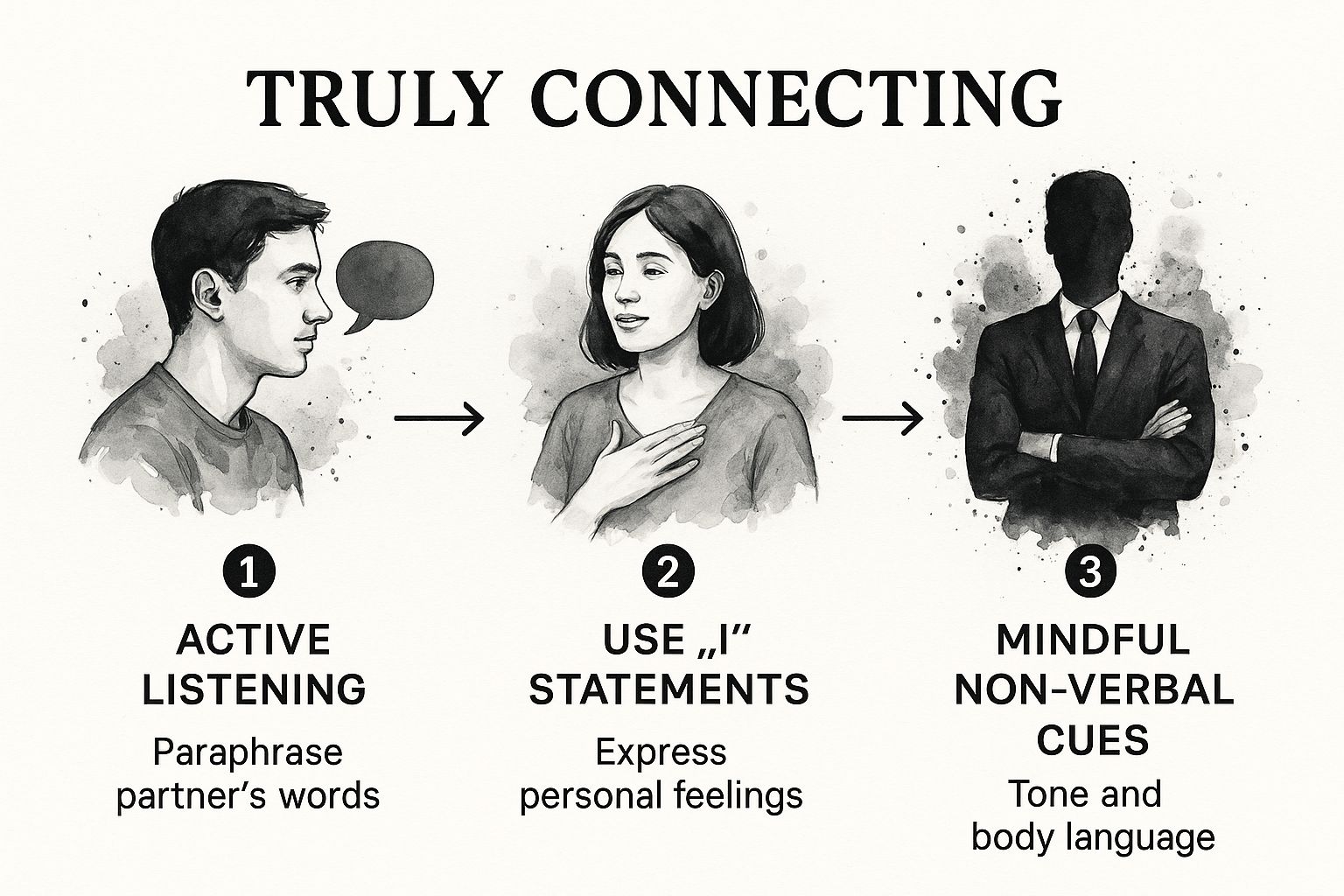Improving your relationship isn't about some grand, sweeping gesture you see in the movies. It’s actually built in the small, quiet moments—the consistent and intentional actions you take every single day. The real path to a deeper, more fulfilling connection is paved with meaningful communication, shared experiences, and a foundation of mutual respect.
The Real Foundation of a Stronger Relationship

So many of us get caught up in the idea that a thriving partnership requires dramatic, rom-com-worthy moments. But the truth? The strongest bonds are forged in the simple, everyday choices we make for each other. It’s less about that one spectacular vacation and much more about how you greet each other after a long, stressful day.
This guide is designed to cut through the clichés and give you practical, real-world strategies that actually work to strengthen your bond.
A healthy relationship really boils down to a few key pillars. When you understand and actively nurture these areas, you can transform your connection from just coexisting to truly thriving together. Think of them not as abstract concepts, but as actionable goals.
- Meaningful Communication: This is so much more than just talking. It’s about listening with the intent to understand, not just to reply. It's about learning to express your own needs and feelings without casting blame.
- Shared Experiences: Creating new memories together—whether it's a weekend getaway or just trying a new recipe on a Tuesday night—strengthens your bond. It reminds you that you’re a team navigating life's journey, side-by-side.
- Mutual Respect: This is fundamental. It means genuinely valuing your partner's opinions, honoring their boundaries, and appreciating them for who they are, not just for what they do for you.
Why This Matters More Than You Think
Investing in your relationship is hands-down one of the most important investments you can make for your overall well-being. It's not just a nice thought; it's backed by science.
Groundbreaking research, like the ongoing Harvard Study of Adult Development, has shown that the single greatest predictor of our happiness and longevity isn't wealth or fame—it's the quality of our close relationships. Strong connections act as a buffer against life's biggest stressors, directly impacting both our mental and physical health.
You can dive deeper into how relationships shape our lives and get some great insights from the full study on Nouri.ai.
The quality of our relationships is a powerful determinant of our happiness. Neglecting them has real consequences, but nurturing them pays dividends in every aspect of life.
The goal here is to focus on the small, consistent efforts that create lasting, positive change.
To help you get started, here's a simple breakdown of the core areas where you can focus your energy to see the biggest impact on your relationship.
Key Areas for Relationship Improvement
This table highlights the foundational pillars for a stronger partnership, outlining the primary goal and a practical action you can take for each.
| Pillar | Primary Goal | Key Action Example |
|---|---|---|
| Communication | To foster open, honest, and blame-free dialogue. | Set aside 20 minutes each evening to talk without distractions (no phones allowed). |
| Shared Experiences | To create new, positive memories that strengthen the bond. | Plan one new activity or date night each month, taking turns to choose. |
| Mutual Respect | To validate and honor each other's feelings and boundaries. | Practice active listening: summarize your partner’s point before sharing your own. |
| Intimacy | To maintain both physical and emotional closeness. | Make a conscious effort to show physical affection daily (hugs, holding hands). |
By focusing on these core areas, you can begin to see a real, tangible difference in your connection. If you're looking for more ways to build a strong foundation, be sure to check out our guide on the most important healthy relationship habits.
Moving Beyond Just Talking to Truly Connecting
We’ve all heard it a thousand times: "Communication is key." But if it were that simple, wouldn't we all be relationship gurus by now? The truth is, just talking more isn't the solution. The real goal is to upgrade the quality of that communication—to turn simple chatter into a genuine, heartfelt connection.
So many couples fall into the trap of talking at each other. Conversations become a boring routine of logistics ("Did you pick up the milk?") or, worse, a minefield of defensive jabs. This isn't connection; it's co-existence. Real connection blossoms when both people feel seen, heard, and genuinely understood.
To get there, you need to master a few effective communication strategies. This isn't about learning secret conversational tricks; it's about shifting your entire mindset from trying to win a fight to trying to solve a problem together.
The Power of Active Listening
Active listening is a total game-changer, and it’s about so much more than just shutting up while your partner talks. It's an all-in effort to truly grasp the meaning and, more importantly, the feeling behind their words. You're not just waiting for your turn to speak; you're listening to understand.
One of the most powerful ways to do this is by paraphrasing. It sounds simple, but it works wonders.
After your partner shares something, just say, "Okay, so what I'm hearing is…" and then repeat their point back to them in your own words. This does two amazing things at once: it proves you were actually listening, and it gives them a chance to correct you if you got it wrong. It’s a simple move that can instantly cool down a heated moment because it shows you care enough to get on the same page.
From Accusation to Expression with "I" Statements
When we’re hurt or annoyed, our first instinct is often to point the finger. Sentences fly out starting with "You…" like "You never help around the house," or "You always cut me off." These "You" statements are like conversation-enders. They immediately force your partner into a defensive crouch, and just like that, you're in a fight, not a discussion.
There’s a much better way: using "I" statements. This simple tweak shifts the focus from your partner's perceived wrongdoing to your own feelings.
Here’s how you can flip the script from blame to connection:
- Instead of: "You're always late and you obviously don't care about my time."
- Try this: "I feel really unimportant and anxious when I'm left waiting for a long time."
- Instead of: "You never listen to me."
- Try this: "I feel dismissed when I'm trying to talk and I don't have your full attention."
See the difference? It's not just about changing a word. It's about owning your emotions and inviting your partner into your world instead of attacking them for their behavior. For more real-world examples, our full guide on improving communication in relationships goes even deeper.
Key Takeaway: An "I" statement frames a problem from your perspective, turning it into something you can tackle as a team. A "You" statement feels like an attack, leaving your partner with only two choices: shut down or fight back.
More Than Words: Non-Verbal Cues
We’ve all seen the stats—a massive chunk of our communication isn’t verbal at all. Your tone of voice, the way you hold your body, your facial expressions… these things can either reinforce what you're saying or completely undermine it.
Let's play out a common scene: one partner gets home late from work.
- Scenario A (The Escalation): The waiting partner is standing with their arms crossed, foot tapping. As the other person walks in, they say, "Glad you could finally make it," in a voice dripping with sarcasm. The fight has already started.
- Scenario B (The Connection): The waiting partner is on the couch. They look up, make eye contact, and say, "Hey, I was getting a little worried. Is everything okay?" The tone is calm and concerned.
The words are part of it, sure, but the non-verbal cues are what really set the tone. Crossed arms and a sharp voice scream "I'm angry," creating an instant barrier. An open posture and a gentle tone, on the other hand, invite empathy and explanation. Just being mindful of these silent signals can be the difference between a nasty fight and a moment of genuine reconnection.
How to Rebuild and Strengthen Trust
Trust is the bedrock of any lasting relationship, but it's not something you build overnight. It isn't a one-time decision or some grand declaration you make to each other. Instead, trust is the quiet result of hundreds of small, consistent, and dependable actions that add up over time. Nurturing it is a continuous process, and it's absolutely essential if you want your relationship to go the distance.
At its core, trust really boils down to two things: reliability and emotional safety. Reliability is all about following through. It’s knowing your partner will call when they say they will, or that they'll handle a major responsibility you've both agreed on. Emotional safety, on the other hand, is about creating a space where your partner feels completely secure being vulnerable—without ever fearing judgment or ridicule.
The Small Actions That Build a Strong Foundation
Every time you remember a small detail about your partner's day, actively listen without jumping in to solve their problems, or simply follow through on a minor promise, you're making a deposit in your relationship's trust bank. These moments might seem insignificant on their own, but they weave together to create a powerful pattern of dependability.
Think about it. Putting your phone away during dinner sends a clear message: "You are my priority right now." Conversely, consistently showing up late without a heads-up slowly chips away at that foundation, subtly suggesting that your partner’s time isn’t as valuable as yours.
Trust is maintained by demonstrating through your actions that your partner's well-being is as important to you as your own. It's the assurance that you have each other's backs, no matter what.
This infographic breaks down a simple three-step process for connecting in a way that builds exactly this kind of emotional safety.

As you can see, genuine connection isn't rocket science. It’s about being present and intentional in how you listen, speak, and even carry yourself.
Repairing Trust After a Breach
When trust is broken, the path back can feel overwhelming, but it is possible. The catch? Words alone will never be enough. Rebuilding requires a clear, deliberate process rooted in accountability and proven change. It’s not just about saying "I'm sorry"; it’s about fundamentally changing the behavior that caused the hurt in the first place.
This process involves a few non-negotiable steps:
- A Genuine Apology: This means taking 100% responsibility without any excuses or justifications. An apology that includes the word "but" ("I'm sorry I hurt you, but you…") isn't an apology at all—it's just a way to deflect blame.
- Demonstrated Change: The person who broke the trust has to show, through consistent actions over a long period, that they are committed to changing. This is easily the hardest and most critical part of the entire process.
- Patience and Understanding: The person who was hurt needs time to heal. That healing process is never a straight line. There will be good days and bad days, and that's okay.
Recovering from a major breach of trust is a long and complicated journey. For anyone navigating this difficult path, our detailed guide on how to rebuild trust after betrayal offers a more in-depth roadmap. Just remember, the goal isn't just to get back to how things were, but to build a new, stronger, and more honest foundation together.
Building Intimacy Beyond the Bedroom

When you hear the word "intimacy," where does your mind go? For most of us, it jumps straight to the bedroom. While physical connection is a huge part of a romantic relationship, it's really just one piece of a much bigger, more intricate puzzle.
A truly deep, lasting bond is built on a foundation that weaves together the emotional, intellectual, and experiential parts of your lives. Think of it as a multi-layered connection that makes your relationship resilient. It’s about knowing what’s going on in each other’s heads, sharing ideas that light you up, and building a collection of memories that belong only to the two of you.
When life gets hectic or stressful, these other forms of intimacy are what keep you close.
Cultivating Emotional Closeness
Emotional intimacy is that feeling of being completely seen, understood, and accepted for who you are. It’s the safety net that lets you share your biggest fears, celebrate your quietest wins, and just be yourself—no filter needed. This kind of closeness doesn't just happen; you have to nurture it with small, consistent habits.
A simple but surprisingly powerful ritual is sharing a "high and low" from your day. This isn't about solving problems; it's a quick, daily check-in that creates a dedicated space to talk about more than just bills and errands. It’s a tiny window into each other’s emotional worlds.
To feel truly close, both partners need to believe they can be vulnerable without judgment. This emotional safety is the fertile ground where all other forms of intimacy can grow.
Another great way to build this bond is by becoming a student of your partner. Pay attention to the little things—what makes them light up, what stresses them out, what little gestures bring them comfort. Remembering these details and acting on them, like grabbing their favorite coffee after a tough morning, speaks volumes.
Connecting Through Shared Minds and Experiences
Beyond the emotional side of things, there are other powerful ways to connect that often get overlooked. Let's talk about intellectual and experiential intimacy—it's all about engaging your minds and creating new stories together.
And no, this doesn’t require grand gestures or expensive trips. It's about weaving a shared narrative through your everyday life.
- Intellectual Intimacy: Read the same book or a fascinating article online. Listen to a podcast together on a drive or watch a documentary you've both been curious about. The magic happens in the conversation afterward. What did you think? Did you agree with the conclusion? Seeing how your partner’s mind works is an incredibly powerful form of connection.
- Experiential Intimacy: This is just a fancy way of saying "do stuff together." Create a shared history. Try tackling a new recipe you found, attempt a DIY project, or even just take a different route on your evening walk. The outcome doesn’t matter nearly as much as the shared experience of figuring something out as a team.
Celebrating these shared experiences is key, too. Looking into meaningful wedding anniversary gifts can be a beautiful way to honor your enduring love and reaffirm the very bond you're working to deepen. It’s these moments, both big and small, that become the building blocks of a life together.
A global survey by Ipsos really drives this point home. While 76% of people across 30 countries feel loved, only 59% are actually happy with their romantic lives. Interestingly, millennials report the highest satisfaction rates at 63%. This gap suggests that actively nurturing all facets of intimacy is crucial for bridging the divide between simply feeling loved and feeling truly satisfied in your relationship. You can find more insights from the full global relationship study.
Turning Conflict Into an Opportunity for Growth

Let's be real: every single couple on the planet has disagreements. The idea of a conflict-free relationship is a total fantasy. The true mark of a strong partnership isn’t the absence of arguments, but rather how you both navigate them when they pop up.
Conflict doesn’t have to be a red flag. When you learn to handle it constructively, it’s actually a powerful way to understand each other on a much deeper level and seriously strengthen your connection. It's an opening to grow, both as individuals and as a unit.
The key is to flip your perspective from "me vs. you" to "us vs. the problem." The moment you start seeing a disagreement as a shared challenge to tackle together, the entire dynamic shifts. It’s no longer a battle; it’s a team project.
Your Playbook for Healthier Arguments
Jumping into a tough conversation without a plan, especially when you’re tired or stressed, is a recipe for disaster. You have to be intentional about how and when you bring things up.
Pick your moment wisely. Don't start a heavy conversation at 11 p.m. after a brutal day or as one of you is rushing out the door. Just as important, stick to one issue at a time. Dragging up old grievances from months ago will only muddy the waters and make your partner feel like they're being ambushed.
Keep the focus laser-sharp on the problem at hand. This is how you stop a conversation from spiraling into a blame game that solves absolutely nothing.
The point of a relationship conflict isn't to win the argument. The real victory is when both of you walk away feeling heard, respected, and understood.
This hopeful view on working through issues is more widespread than you might think. One industry study found that among married women, 44.1% sought counseling specifically to improve their marriages. A staggering 80% of them went into it with optimism, genuinely expecting positive changes. This shows a powerful belief in the potential for growth. You can check out more on this positive outlook on marriage improvement.
Knowing When to Hit Pause
Sometimes, even with the best intentions, emotions just get too hot to handle. You can feel it—your heart starts pounding, your voice gets louder, and your rational brain checks out. Pushing through the conversation at this point is almost always a bad idea.
This is where a strategic timeout becomes your best friend.
- Agree on a signal: Come up with a simple, neutral phrase either of you can use, like "I need a break."
- Set a return time: This is the most important part. A timeout isn’t about running away from the problem. Agree to come back to the conversation in a specific timeframe, whether it's 30 minutes or an hour.
- Cool down productively: During the break, do something that actually calms you down. Go for a quick walk, put on some music, or just focus on your breathing. Whatever you do, don't just sit there stewing over the argument.
This simple practice can stop you from saying things you’ll regret later. It gives you both a chance to reset and come back to the conversation with a clearer head, ready to actually solve the problem as a team.
Common Questions About Improving Your Relationship
Putting new strategies into practice can feel exciting, but it always brings up real-world questions. It’s one thing to read about "I" statements in an article, and a completely different thing to actually use one in the middle of a tense conversation.
Let's tackle a few of the most common concerns that come up when you start this journey.
One of the biggest hurdles people face is figuring out how to start this work when their partner seems hesitant, or even resistant. The key is to avoid making it sound like an accusation or a chore.
Instead of hitting them with, "We need to fix our relationship," try framing it as a positive, shared goal. You might say something like, "I've been thinking about how we can have more fun together, and I'd love for us to try some new things to feel closer." It's all about the invitation, not the ultimatum.
How Soon Can We Expect to See Real Changes?
Genuine improvement in a relationship isn't an overnight fix. It’s a gradual process built on one consistent action after another. While you might feel a positive shift after just one really good conversation, lasting change takes time.
Think of it like building any new habit. You’ll probably see small wins within a few weeks of consistent effort—maybe fewer misunderstandings or more spontaneous moments of connection. But if you're working on rebuilding deep trust or fundamentally changing communication patterns that have been around for years, that can take several months.
The goal isn't speed, it's sustainability. Focus on making small, consistent efforts every day rather than holding out for some dramatic breakthrough. Patience is just as important as action here.
True transformation happens when these new, healthier behaviors become your natural default, not just something you’re consciously trying to remember to do.
When Should We Consider Professional Help?
There is absolutely zero shame in bringing in a professional. Honestly, it's a sign of incredible strength and a deep commitment to your relationship.
You might want to consider seeking help from a couples therapist if you notice these patterns:
- You're Stuck in a Cycle: You keep having the same arguments over and over again with no real resolution in sight.
- Trust Has Been Broken: There’s been a major breach, like infidelity, that you just can't seem to navigate on your own.
- Communication Feels Impossible: One or both of you has emotionally withdrawn, or every conversation feels like a minefield of criticism.
A good therapist provides a neutral space and gives you proven tools to handle conflict and actually hear each other again. See it as an investment in the future you want to build together.
At Poke Match, we provide expert advice and practical strategies to help you build stronger, healthier connections. Explore our resources to continue your journey toward a more fulfilling relationship. Learn more at https://poke-match.com.
